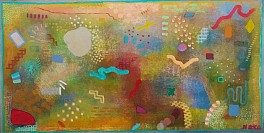BIOGRAPHY

American, 1930-2010
Described as the "author of a dappled infinite," Natkin created some of the most innovative color abstractions of the late 20th century. Populated by stripes, dots, grids, and an array of free-floating forms, his light- filled canvases are sensuous, playful, and visually complex.
While attending the school of the Art Institute of Chicago from 1948 to 1952, Natkin was afforded the opportunity to study the museum's world-class collection of French post-impressionist art and decided to turn his attention to painting instead. During these formative years, Natkin was inspired by the examples of Pierre Bonnard and Henri Matisse, who used decorative patterning and arbitrary color to evoke mood. Most importantly, he also discovered the work of Paul Klee, the Swiss-German artist whose whimsical, semi-abstract paintings reflected his belief that "art does not reproduce the visible but makes visible"--a credo that nurtured Natkin's burgeoning interest in emotional content.
In 1952, he lived briefly in New York, where he saw and was influenced by the bold canvases of Willem de Kooning. In 1959, aware of the limited patronage for abstract art in Chicago, Natkin and Dolnick moved to New York, where Natkin joined the stable of artists associated with the Poindexter Gallery, known for its support of emerging painters and sculptors. Immersed in the dynamism of the New York art world, where Abstract Expressionism and Color-Field painting were the dominant styles of the day, Natkin's aesthetic approach continued to evolve. In 1961, he adopted a serial approach to painting, a practice he would adhere to throughout his career.
Natkin began to develop a more intricate style (indebted to Klee), depicting diamonds, polygons, ovals, squiggles and other shapes against textured, delicately toned backgrounds interspersed with seemingly randomly placed dots and daubs of pigment and areas of crosshatching. This new style is evident in the "Intimate Lighting" series works.
In 1970 Natkin put aside his brushes and began to use sponges, soaked in acrylic paint and wrapped in pieces of cloth or netting, which he would apply to his support with different levels of pressure, a technique that enhanced the decorative quality of his paintings. The artist first applied this methodology to his Intimate Lighting series, which was influenced by an exhibition of cubist painting that he saw at The Metropolitan Museum of Art in New York. The year 1971 also marked a pivotal moment in Natkin's career in that he had the first of many one-man shows at the venerable André Emmerich Gallery in New York.
Natkin's work can be found in the collections of the Hirshorn, the Met, LACMA, the Art Institute of Chicago, MOMA, the Guggenheim, the Whitney, and many other museums.
